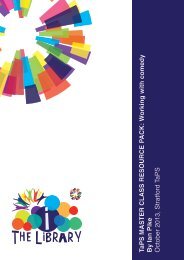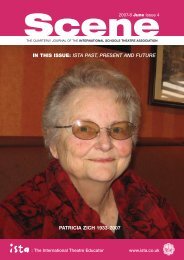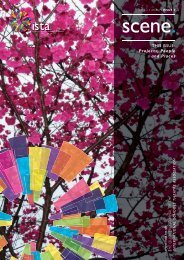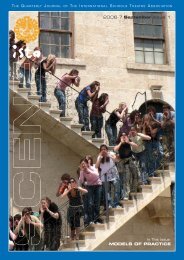ISTA/Scene March 07
ISTA/Scene March 07
ISTA/Scene March 07
You also want an ePaper? Increase the reach of your titles
YUMPU automatically turns print PDFs into web optimized ePapers that Google loves.
estricting our set to black boxes and<br />
platforms. The stage was a fluid area<br />
through which students moved freely,<br />
as if in a school, including moving from<br />
the performance space into the<br />
instrumental area. This text was<br />
extremely flexible and we felt that we<br />
could adjust it to match our group’s<br />
strengths effectively. GREASE, of<br />
course, is an old stand-by. While there<br />
aren’t many ‘moments’ in the text that<br />
challenge actors emotionally, it is such<br />
good fun that students challenge<br />
themselves. We really focused on<br />
character acting and comedic timing<br />
for this one. We spent eight weeks in<br />
rehearsals (three meetings a week),<br />
splitting time among choreographic,<br />
dramatic, and music rehearsals. We<br />
had a stationary set consisting of a<br />
scaffolding platform with a stage-right<br />
staircase and backstage access, a set<br />
of lockers and several benches that<br />
served multiple purposes.<br />
INTERVIEW: a one act play from<br />
AMERICAN HURRAH published by<br />
Dramatists Play Service, available<br />
alone or with AMERICAN HURRAH,<br />
www.dramatists.com<br />
High School<br />
This is a fantastic text to challenge<br />
drama students. It is approximately 20<br />
minutes long but those twenty minutes<br />
are extremely intense and demanding.<br />
The first half of the play consists of<br />
four anonymous interviewers<br />
bombarding four ‘average’ people with<br />
questions regarding their lives and<br />
work experiences. The audience<br />
understands that this questioning<br />
process in meant to approximate the<br />
situation of a job interview. However, in<br />
the absurd world of the play, the<br />
questions drift away from reality,<br />
becoming more and more absurd and<br />
seemingly more and more probing,<br />
even diabolical. The second half of the<br />
play follows the same characters<br />
through a series of monologues that<br />
move the action from the impersonal,<br />
surface realm of the first half to a more<br />
internal realm. Overall, the play is a<br />
fairly cynical statement on life,<br />
suggesting that the world is a cold,<br />
impersonal place where only the fittest,<br />
or cleverest, survive. In terms of style,<br />
the play verges on the absurd. It is<br />
very fast-paced and requires a strong<br />
sense of timing. While individual actors<br />
will be challenged and showcased, the<br />
play provides tremendous<br />
opportunities for creative ensemble<br />
work. It has a minimal set (eight chairs<br />
or boxes) and technical demands and<br />
is very flexible in terms of performance<br />
space. We developed it over the<br />
course of about five rehearsals for a<br />
one-off performance, but I have also<br />
used it as a contest piece and as part<br />
of an evening of one-acts.<br />
Keith LeFever – Schule Schloss<br />
Salem, Germany<br />
UBU REX by Alfred Jarry<br />
We read this play in our middle school<br />
theater workshop session looking at<br />
possible sections for scene work. The<br />
students were so fascinated by the<br />
intensity of the play that we decided to<br />
produce it for Parents Day, which was<br />
five months away. At first we would<br />
read a scene, then use the basic<br />
structure to improvise. In this way we<br />
could experiment with the play and<br />
find our own levels of expression. We<br />
also cast the play using the<br />
improvisations as the basis for<br />
character selection. We ended up<br />
having most of the main roles played<br />
by girls; only Tatzensaum and Bubelas<br />
were played by boys. Then we brought<br />
in a professional acting coach from the<br />
National Theater in Mannheim, to do<br />
an intensive two-day workshop on<br />
body language and extreme forms of<br />
expression, using masks and group<br />
exercises. We developed ideas such<br />
as slow-motion racing, the ‘great<br />
escape’ of the Queen and Bubelas<br />
over 12 meters long being supported<br />
only by bodies and not touching the<br />
floor, finger puppets to represent<br />
thousands of angry citizens, and using<br />
shadows as a method of execution.<br />
Our four musicians used tools that<br />
they found in the janitor’s room as their<br />
instruments. We used the floor of our<br />
Gym as the stage and it was 6 meters<br />
wide and 16 meters long. We had the<br />
audience raised on two sides with the<br />
stage being in the middle. At each end<br />
we had a two level scaffold and two<br />
Beijing MS<br />
wooden slides which lead down to the<br />
main stage. This provided plenty of<br />
space for the 28 actors and gave us<br />
endless possibilities for movement and<br />
the ‘crowd’ scenes. The entire tech<br />
was done by the middle school<br />
students. The lighting was particularly<br />
complicated and detailed and<br />
demanded long hours to hang and<br />
focus. The make up crew had a blast<br />
as we let them free to come up with<br />
outlandish designs, which produced a<br />
green Ubu with bones, bugs, and body<br />
parts in his hair. We had a wave of<br />
illness that reached the cast; therefore<br />
our rehearsal time was cut short. We<br />
asked the school if we couldn’t use<br />
some class time to finish the play, our<br />
request was rejected. Therefore we<br />
showed the rise of Ubu, but not the fall.<br />
THE LEARNED LADIES by Moliére<br />
This play we performed with the high<br />
school group as a main stage<br />
production. As usual we were<br />
searching for a play with strong female<br />
roles as the balance of power in our<br />
theater group hardly ever swings the<br />
other way. Most of the group had<br />
exceptional speech skills and had been<br />
with me for almost four years. The play<br />
has wonderful themes such as family<br />
dynamic, intellectual snobbery and, of<br />
course, the role of women in society.<br />
We used a great German translation<br />
that was modern and phonetically<br />
ingenious. Because of the language<br />
we decided to set the play in the fifties<br />
which had some of the same attitudes<br />
toward women, daughters, and<br />
intellectuals as in Moliére’s time... more<br />
or less. The choice helped our prop<br />
and costume department and cut<br />
down on our overall production costs.<br />
We had the stage set up in a sort of<br />
thrust mode, which was shaped more<br />
like a “T”, with the living room jutting<br />
out with the bar and entrances at the<br />
back. Having the audience on three<br />
sides increased the intimacy of the<br />
<strong>Scene</strong> | 2006-7 <strong>March</strong> Issue 3 | 13

















